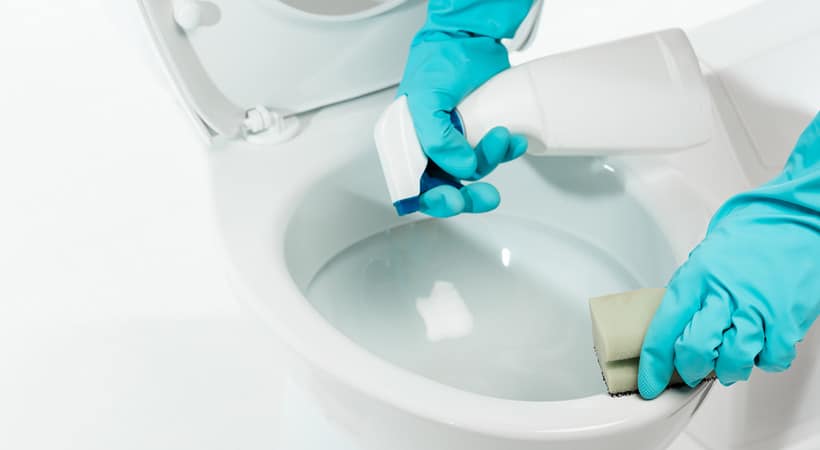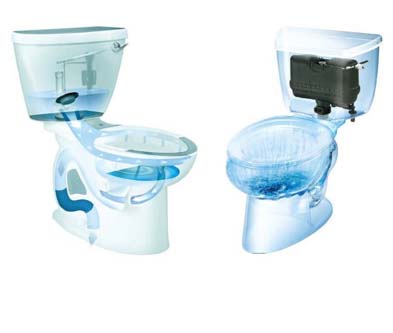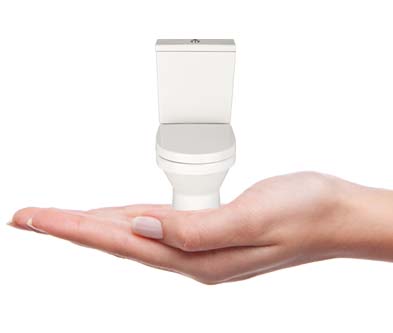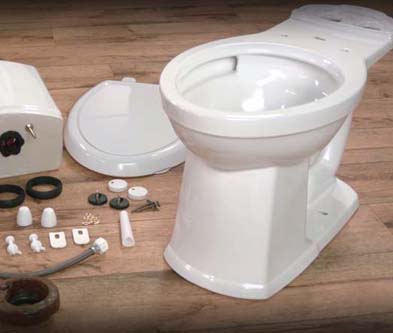Toilet Found! is sustained by readers who made purchases through specific links on this site. Learn more
Cross-Contamination in the Bathroom – Stop the Bug at the Toilet

The Role of Toilets in Bathroom Hygiene and Cross-Contamination Prevention
Cross-contamination isn’t a topic that is limited to just kitchens or medical facilities. In fact, your very own bathroom can become a breeding ground for harmful bacteria, fungi, and viruses if not maintained correctly. Remember, the bathroom is a place where we aim to achieve personal hygiene.
However, the irony is that it can sometimes be the very source of potential infections due to cross-contamination. One of the primary culprits behind this problem is the humble toilet.
By understanding and addressing the avenues for cross-contamination in your bathrooms, especially from the toilet, you can ensure a safer and more sanitary environment for yourselves and your loved ones.
Understanding Cross-Contamination in the Bathroom
The unintentional transfer of harmful microorganisms from one surface to another should always be prevented. This can occur in bathrooms when germs from fecal matter and toilet water become aerosolized during flushing and settle on various surfaces. Or when hands touch contaminated surfaces and other objects or parts of the body. Given the humidity and moisture prevalent in bathrooms, they offer an ideal environment for microbial growth.
Cross-contamination can lead to various illnesses, including gastrointestinal, respiratory, and skin infections. This particularly concerns vulnerable individuals such as older people, children, or those with compromised immune systems. Furthermore, cross-contamination can also occur through shared items such as towels, toothbrushes, or razors.
Maintaining a high degree of cleanliness in the bathroom is essential to minimize the risk of cross-contamination. This includes regular cleaning and disinfection of surfaces, proper hand hygiene, and avoiding sharing personal items. Additionally, closing the toilet lid before flushing can significantly reduce the aerosolization of pathogens.
The Aerosol Effect and Flushing
When you flush a toilet without closing the lid, a phenomenon known as a “toilet plume” can occur. This is where a mist of tiny droplets of toilet water rises into the air, potentially carrying with it bacteria and viruses from the toilet bowl. This aerosol can settle on nearby surfaces, like your toothbrush, soap, towels, and faucets, thereby becoming a source of contamination.
The aerosol effect of flushing creates a major health concern, especially in public restrooms, which numerous individuals use throughout the day. It is not just the direct users of the toilet who are at risk but also those who enter the bathroom afterward.
The bacteria and viruses can live on surfaces for hours or even days. This means that even if you haven’t used the toilet but simply touched a contaminated surface and then touched your face, you could be exposed to harmful pathogens.
Therefore, it is crucial to always close the toilet lid before flushing and to maintain proper hand hygiene to minimize the risks of infection. So, the next time you visit a public restroom, make sure to wash your hands first thing when you reach home and change away the clothes before you go around your house. Or you might want to place a Disinfectant Spray and Hand Sanitizer at the house entrance.
Contact Points and Potential Pathways
While the aerosol effect is concerning, it’s not the only risk. The various touchpoints, such as faucet handles, bathroom doorknobs, and light switches, can also harbor germs. If someone uses the bathroom and doesn’t wash their hands thoroughly afterward, they can transfer germs from their hands to these touchpoints. The next person who touches these surfaces may pick up these germs and inadvertently introduce them into their system or spread them around the house.
Moreover, other commonly touched objects, such as toilet handles, toilet bowl rims, soap dispensers, towel racks, and even cleaning tools, can also serve as potential pathways for transmitting harmful pathogens. Even the air can be a medium for spreading dangerous germs, especially in small bathrooms with poor ventilation, where droplets can linger after a person has coughed or sneezed. This emphasizes the importance of good bathroom hygiene.
Regular and thorough cleaning of all surfaces, using appropriate cleaning solutions or disinfectants, can significantly reduce the risk of bacteria contamination. Furthermore, personal hygiene practices such as washing hands correctly and avoiding touching faces can also play a critical role in preventing the spread of germs.
In this time of heightened health awareness, it’s essential to remember that the bathroom, while a private space, can also be a hotspot for germs and needs to be treated with the same caution as other shared spaces.
Effective Strategies to Minimize Risks
- Lid Down Before You Flush: Always close the toilet lid before flushing. This simple act can significantly reduce the aerosol effect and limit the spread of microorganisms.
- Regular Cleaning: Maintain a routine cleaning schedule for your bathroom. Use effective disinfectants, ensuring they remain on surfaces for the time to kill germs.
- Hand Hygiene: Emphasize the importance of thoroughly washing with soap and water for at least 20 seconds. If soap and water aren’t available, use hand sanitizers that contain at least 60% alcohol.
- Keep Essentials Protected: Store toothbrushes, sponges, and towels inside cabinets or use protective covers to limit exposure.
- Educate and Raise Awareness: Make sure all household members, especially children, know the risks and the necessary preventive measures.
Creating a Bathroom Environment Unfavorable for Bacterial Growth
You might often overlook your bathroom when considering spaces requiring stringent hygiene practices. Still, it’s one of the prime places harmful bacteria can thrive. It’s essential to ensure your bathroom environment is as inhospitable to bacteria as possible.
Start by understanding that bacteria love damp, warm environments. By ensuring your bathroom remains dry and well-ventilated, you already take a significant step toward making it unsuitable for bacterial growth. After a hot shower, letting the room air out is crucial. Open a window or use an exhaust fan, if you have one, to dissipate the steam and reduce humidity. This practice prevents bacterial growth and combats mold formation, which can be both a health hazard and an aesthetic concern.
Your choice of bathroom materials can also play a role. Smooth and non-porous surfaces, such as glazed tiles or treated stone, are less conducive to bacterial growth than porous surfaces. If you’re considering a bathroom remodel, it’s wise to invest in these materials as they’re more resistant to bacteria and easier to clean.
And speaking of cleaning, regularity is the key. Even if your bathroom appears clean, invisible bacterial colonies might be growing. A good-quality disinfectant is essential, but remember that overuse can lead to other issues, like bacterial resistance. It’s a balance of ensuring cleanliness without going overboard.
Moreover, personal items like wet towels or bath sponges can be breeding grounds for bacteria. Ensure you dry these items outside the bathroom, preferably in direct sunlight, which is a natural disinfectant.
Lastly, think about decluttering. A cluttered bathroom with numerous products and items can trap moisture and provide numerous hidden corners for bacteria to grow. Keeping your bathroom minimalistic and organized simplifies the cleaning process and reduces potential spots for bacteria to thrive.
Conclusion
The bathroom, while a place of cleansing, has the potential to become a hub for cross-contamination. By recognizing the risks associated with toilets and implementing strategies to combat them, you can ensure that your personal hygiene sanctuaries remain safe and sanitary.
Moreover, the bathroom should not be overlooked when it comes to regular cleaning and maintenance. The cleaning process should cover all surfaces, including the toilet seat, handle, and bowl. They should be thoroughly cleaned and disinfected regularly to eliminate all probabilities of bacterial contamination. Washing your hands properly after using the restroom is also important, as this is a key step in preventing the spread of germs.
Additionally, consider implementing measures like closing the toilet lid before flushing and using separate towels for each family member to further reduce the risk of cross-contamination. With conscious efforts and consistent hygiene practices, you can significantly reduce the risk of disease spread right from our bathrooms.
Finally, creating an environment that prevents bacteria growth is essential to stop the growth of bacteria. This can be achieved by ensuring proper ventilation to keep the bathroom dry and less hospitable for bacteria and mold. Also, don’t forget about the bathroom items like toothbrushes, razors, and towels that can be hotbeds for microbes. These should be replaced or cleaned regularly to avoid bacterial growth.
Integrating these hygiene practices into your daily routine can make a significant difference in maintaining a healthy bathroom. Understanding the role of the bathroom in cross-contamination and disease spread can help us implement effective strategies to maintain cleanliness and prevent illnesses.
With regular cleaning, good personal hygiene, and mindful habits, everyone can transform the bathroom into a clean, safe, and healthy space for all.







